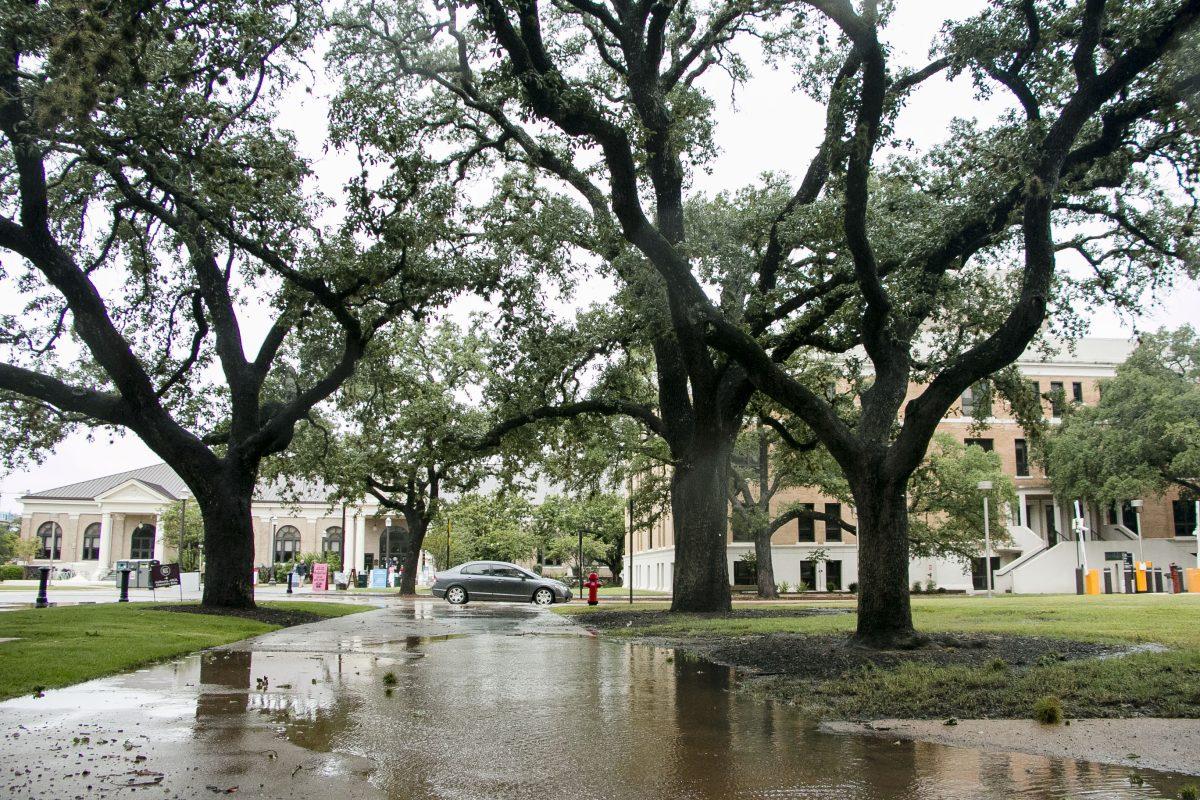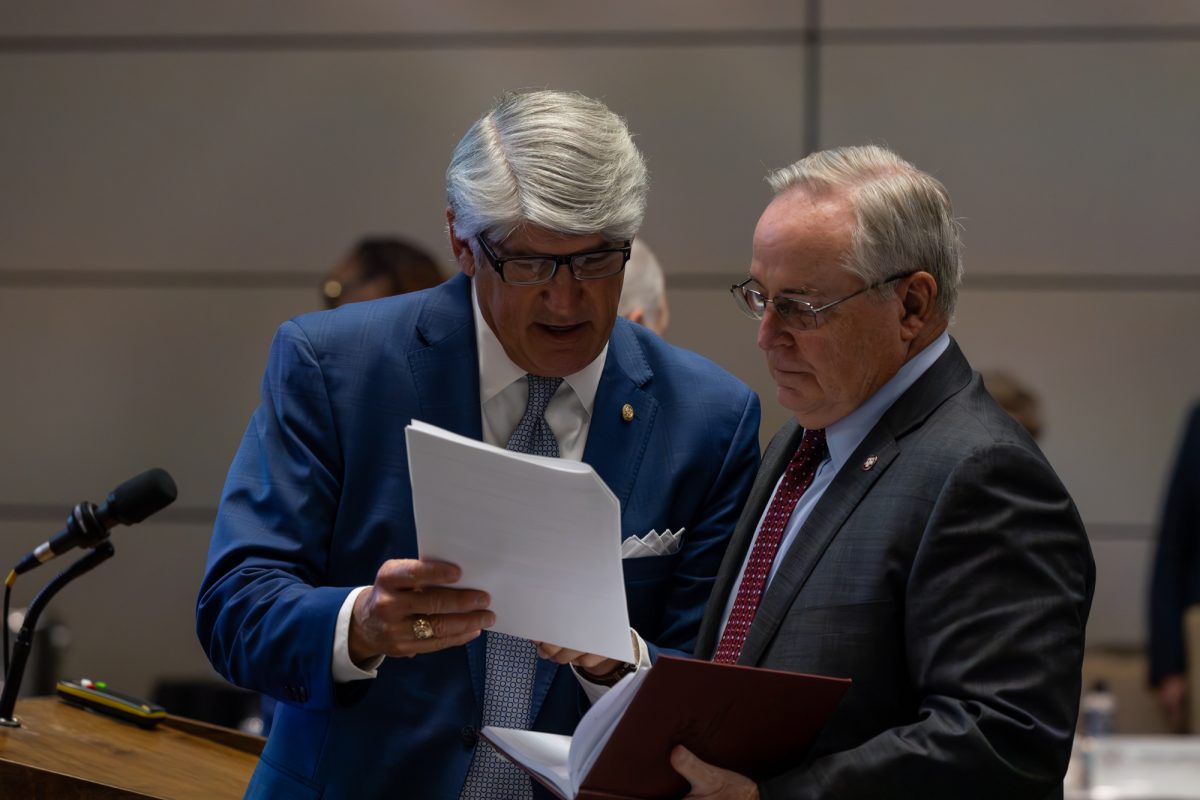Hurricane Harvey landed on the Texas coast on Aug. 24 as the strongest storm to hit the state in over 40 years. Harvey’s impact was felt immediately as it brought extreme winds, flooding and intense rainfall. The Bryan-College Station area was effected, though not as much as the Houston region.
According to The Bryan-College Station Eagle, College Station Mayor Karl Mooney said areas of the city experienced heavy rainfall and some streets were flooded, but there are no reports of water getting inside homes. Mooney also said the city’s water supply is still safe to drink from.
Trash service was interrupted in both Bryan and College Station due to road conditions. College Station trash services will resume the day after regularly scheduled collection day. The Eagle reported that residents are advised to place their trash containers in their driveway or on high ground to avoid the trash being swept away by water.
Two Texas A&M students almost drowned after going swimming in Lake Bryan this past Saturday, leaving both of them in critical condition. Bryan Mayor Andrew Nelson cautioned residents to stay safe, despite the waters beginning to recede, according to The Eagle.
“I can’t say enough how unwise it is to go out into bodies of water in the middle of a tropical storm,” Nelson told The Eagle. “Don’t go anywhere unless you have to. If you don’t have to be out there, don’t.”
Associate atmospheric sciences professor Robert Korty said it was the warm August weather that allowed Harvey to build up to the scale that it did, and make the western Gulf of Mexico the perfect breeding ground for the storm.
“Conditions in the western Gulf of Mexico were ripe for strengthening, and unfortunately Harvey entered at the right time to capitalize on them,” Korty said. “Water temperatures are at their warmest this time of year and the Gulf is running warmer than average this summer. Additionally there was no wind shear to impeded cyclone formation.”
Texas State Climatologist and Regents professor of atmospheric sciences John Nielsen-Gammon said that the Gulf of Mexico was warmer than originally anticipated, which helped Harvey form.
“The Gulf of Mexico was unusually warm,” Nielsen-Gammon said. “The western Gulf averaged about one degree Celsius warmer than normal, so that probably helped Harvey to intensify. We were expecting an active hurricane season anyway because of the warm temperatures across the tropical Atlantic.”
Atmospheric sciences professor Courtney Schumacher said that Harvey was kept stationary over Texas by large-scale weather patterns for several days after it made landfall.
Schumacher said that in a historical sense, Harvey is the 17th strongest hurricane to make landfall in the U.S. since 1851. “Texas has had only a few stronger landfalling hurricanes during that time, including the 1900 Galveston storm that killed many thousands of people from storm surge,” Schumacher said. “Other Texas storms have produced extremely large rain amounts on the coast, like Tropical Storm Allison in 2001, but Harvey is expected to exceed those devastating rain amounts over larger areas.”
According to the Office of the Texas State Climatologist, Harvey already ranks in the top five for rainfall brought by a storm, with more to come.
“Regarding rainfall, Harvey was the biggest storm ever. Not only did it break the continental U.S. record for single storm rainfall, but in terms of sheer volume of water in a limited area, Harvey exceeds all predecessors,” Nielsen-Gammon said. “Consider this: Approximately 20,000 square miles of Texas and Louisiana received at least 18 inches of rainfall. The total volume is equal to the average discharge of the Mississippi River for three weeks, except it was compressed into four days and deposited onto a major city rather than into the Gulf of Mexico.”
Schumacher added global warming likely played a role in the massive rate of rainfall Harvey brought with it.
“Discussion among hurricane and climate science experts supports the fact that global warming likely had some role in the extreme rain amounts associated with Harvey, but that coastal infrastructure changes via an increase in roads and buildings in lowlying areas exacerbated damage and storm impacts more significantly,” Schumacher said.
Nielsen-Gammon said that Texas will be at risk for future flooding until the rivers drain out.
“Until the rivers drain and the ground dries out, southeast Texas will be susceptible to additional flooding,” Nielson-Gammon said. “It will take less rain than usual to produce flooding because rivers are already high and the water can’t soak into the ground.”
Harvey has already wrought immense damage in it’s wake, and both Korty and Schumacher said Harvey will go down as one of the most damaging storms in American history. According to a Fox Business report, Harvey could cost Houston $50 billion in property damage alone.
“In addition to the destruction around Rockport where the storm came ashore, the epic flooding in the Houston metropolitan area alone would make this a historic storm,” Korty said. “River flooding is a third problem still to come, as the lower Brazos, Colorado and other rivers crest from inland rains later this week. Any one of these components would have made Harvey a historic storm, and this storm has all three.”
Nielsen-Gammon added that an increase in mosquito activity will be another effect of Harvey, and that the storm may set a new precedent for safety measures.
“Depending on the extent of water damage and the amount of rebuilding that must occur, there will be increases in the cost of many building supplies,” Nielsen-Gammon said. “The storm may cause the Houston area to reevaluate the margin of safety it demands against floodwaters. Mosquitoes will be engaging in a breeding frenzy.”
Korty added that we are currently in the peak weeks of hurricane season, so it would be a prime time for another storm to build up. He said that right now, there is one affecting the Carolinas and another is likely to form in the far eastern Atlantic.
Both Korty and Schumacher said that despite the impact left by Harvey, one hurricane can’t affect the seasonal weather. Once the storm has passed, the upcoming fall weather should return. Nielsen-Gammon added that the wet soil will make additional high temperature weather unlikely, but that humidity will be higher than normal for a while.
Devastation in Texas and the damage of Hurricane Harvey
August 30, 2017
Photo by by Savannah Mehrtens
As Hurricane Harvey remains steadily focused over Texas as a tropical storm, inland cities begin to see heavy rainfall and wind gusts.
0
Donate to The Battalion
$2065
$5000
Contributed
Our Goal
Your donation will support the student journalists of Texas A&M University - College Station. Your contribution will allow us to purchase equipment and cover our annual website hosting costs, in addition to paying freelance staffers for their work, travel costs for coverage and more!
More to Discover










